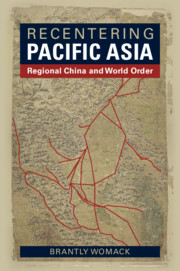Book contents
- Recentering Pacific Asia
- Recentering Pacific Asia
- Copyright page
- Contents
- Figures
- Table
- Author and Commentators
- Acknowledgements
- Note on the Cover Map
- Introduction
- 1 Continuities in China’s Pacific Asian Centrality
- 2 Thin Connectivity
- Commentary
- 3 Sharp Connectivity
- Commentary
- 4 Thick Connectivity
- Commentary
- 5 China, Pacific Asia, and Reconfiguring a Multinodal World
- Commentary
- 6 Global Power Rivalry, Pacific Asia, and World Order
- Bibliography
- Index
1 - Continuities in China’s Pacific Asian Centrality
Published online by Cambridge University Press: 03 August 2023
- Recentering Pacific Asia
- Recentering Pacific Asia
- Copyright page
- Contents
- Figures
- Table
- Author and Commentators
- Acknowledgements
- Note on the Cover Map
- Introduction
- 1 Continuities in China’s Pacific Asian Centrality
- 2 Thin Connectivity
- Commentary
- 3 Sharp Connectivity
- Commentary
- 4 Thick Connectivity
- Commentary
- 5 China, Pacific Asia, and Reconfiguring a Multinodal World
- Commentary
- 6 Global Power Rivalry, Pacific Asia, and World Order
- Bibliography
- Index
Summary
Given China’s position in Pacific Asia, defining its regional centrality might seem a simple task. But centralities grander than merely geographical have been alleged and contested. Currently some maintain that China is the central kingdom because of its power. But it was conquered by the Mongols and the Manchus, and its present centrality is due more to its economic mass and connectivity than to its military. Others claim that hierarchy is natural to Asian culture, and China is the apex. But neighbors were often cynical about China’s moral stature, and China’s soft power is now at a low ebb. I argue that China was the center of regional attention in the premodern era, and that it has returned to center stage since 2008. The three basic reasons for China’s original centrality and its return were situational: presence, population, and production. The salience of all three disappeared with Western imperialism’s global presence, the devaluation of mere demography, and industrial production. Traditional and current centrality created asymmetric relationships between China and its neighbors, but the regional situations differ fundamentally.
Keywords
- Type
- Chapter
- Information
- Recentering Pacific AsiaRegional China and World Order, pp. 23 - 44Publisher: Cambridge University PressPrint publication year: 2023

